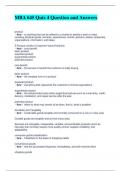MBA 645 Quiz 4 Question and Answers
product
~Ans~ is anything that can be offered to a market to satisfy a want or need,
including physical goods, services, experiences, events, persons, places, properties,
organizations, information, and ideas.
5 Product Levels of Customer Value Hierarchy
~Ans~ core benefit
basic product
expected product
augmented product
potential product
core benefit
~Ans~ the service or benefit the customer is really buying
basic product
~Ans~ the simplest form of a product
expected product
~Ans~ everything that represents the customer's minimal expectations
augmented product
~Ans~ the actual product plus other supporting features such as a warranty, credit,
delivery, installation, and repair service after the sale
potential product
~Ans~ refers to what may remain to be done, that is, what is possible
Durability and Tangibility
~Ans~ nondurable goods tangible and normally consumed in a one or a few uses
Durable goods are tangible and survive many uses.
Services are intangible, inseparable, variable, and perishable products (such as
haircuts) that normally require more quality control, supplier credibility, and
adaptability.
consumer-goods classification
~Ans~ Classified on the basis of shopping habits
convenience goods
~Ans~ that are purchased frequently, immediately, and with minimal effort
shopping goods
, ~Ans~ (such as furniture) that consumers compare on such bases as suitability,
quality, price, and style;
specialty goods
~Ans~ (such as cars) with unique characteristics or brand identification for which
enough buyers are willing to make a special purchasing effort
unsought goods
~Ans~ (such as smoke detectors) that the consumer does not know about or
normally think of buying.
Industrial-Goods Classification
~Ans~ materials and parts, capital items, supplies and business services
capital items
~Ans~ are long-lasting goods that facilitate developing or managing the finished
product, including installations (factories) and equipment (tools). Supplies and
business services are short-term goods and services that facilitate developing or
managing the finished product.
Means of Differentiation
~Ans~ form, features, performance quality, conformance quality, durability,
reliability, repairability, style, and customization
Form
~Ans~ refers to the size, shape, or physical structure of a product. For example,
aspirin can be differentiated by dosage size, shape, color, coating, or action time.
Features
~Ans~ Most products can be offered with varying features that supplement their
basic function. A company can identify and select new features by surveying recent
buyers and then calculating customer value versus company cost for each potential
feature.
Performance Quality
~Ans~ is the level at which the product's primary characteristics operate. Firms
should design a performance level appropriate to the target market and competition
(not necessarily the highest level possible) and manage performance quality through
time.
Conformance quality
~Ans~ the degree to which all produced units are identical and meet promised
specifications. A product with low conformance quality will disappoint some buyers.
Durability
~Ans~ a measure of the product's expected operating life under natural or stressful
conditions, is a valued attribute for durable goods. The extra price for durability must
not be excessive, and the product must not be subject to rapid technological
obsolescence.




